
Secamone is a genus of plant in family Apocynaceae, first described as a genus in 1810. It is widespread across much of Africa, northern Australia, southern Asia, with numerous species endemic to Madagascar.

Galium divaricatum is a species of flowering plant in the coffee family known by the common name Lamarck's bedstraw.

Brunfelsia pauciflora is a species of flowering plant in the family Solanaceae, the nightshades. It is endemic to Brazil, and it is grown in cultivation. A shrubby perennial plant grown in gardens, its common names include today, tomorrow together, yesterday, today and tomorrow, morning-noon-and-night, kiss me quick, and Brazil raintree.

Cornus × unalaschkensis is a species of flowering plant in the Cornaceae, the dogwood family. Common names for the plant include Alaskan bunchberry, western cordilleran bunchberry, or simply western bunchberry.
Secamonopsis microphylla is a plant species endemic to southern Madagascar. It is a trailing or erect herb up to 1.5 m tall. Leaves are narrowly oblong, up to 10 mm long. Flowers in groups of 1–3, yellow, tubular, up to 1.2 mm long.
Ceropegia striata is a plant species endemic to Madagascar. It is known only from the Vavavato Massif in the central highlands, at an elevation of approximately 1800 m.
Pentopetia is a plant genus in the family Apocynaceae, first described as a genus in 1844.
Rhodolaena leroyana is a plant in the family Sarcolaenaceae. It is endemic to Madagascar. The specific epithet is for the botanist Jean-François Leroy.

Humbertia is a monotypic genus of flowering plants belonging to the family Convolvulaceae. It only contains one species, Humbertia madagascariensisLam. It is native to Madagascar. It is known in French as bois de fer; it is endemic to southeastern Madagascar where it occurs in humid evergreen forests at altitudes up to about 600 m (2,000 ft).
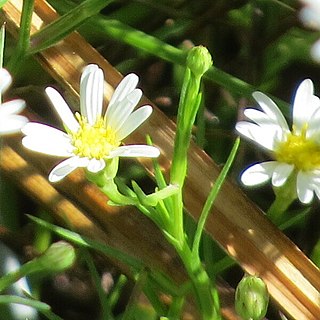
Symphyotrichum potosinum is a species of flowering plant in the family Asteraceae native to Mexico and the U.S. state of Arizona. Commonly known as Santa Rita Mountain aster, it is a perennial, herbaceous plant that may reach heights of 15 to 45 centimeters.
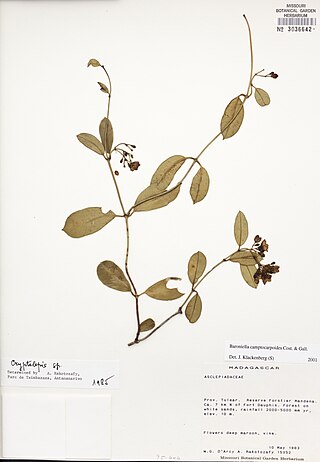
Baroniella camptocarpoides is a species of plant in the Apocynaceae family. It is endemic to Madagascar. Julien Noël Costantin and Ernest-Isidore Gallaud, the botanists who first formally described the species, named it after its resemblance to, but distinctiveness from, plants in the genus Camptocarpus.
Baroniella capillacea is a species of plant in the Apocynaceae family. It is endemic to Madagascar. Jens Klackenberg, the botanist who first formally described the species, named it after very narrow or thread-like leaves.
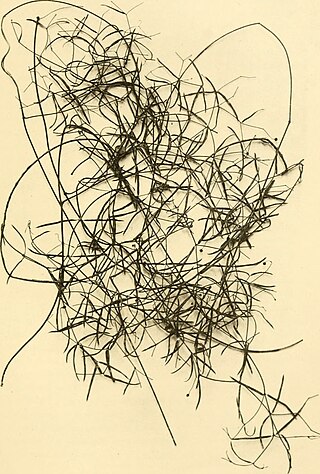
Baroniella linearis is a species of plant in the Apocynaceae family. It is endemic to Madagascar. Pierre Choux, the botanist who first formally described the species using the synonym Baseonema lineare, named it after its narrow leaves.
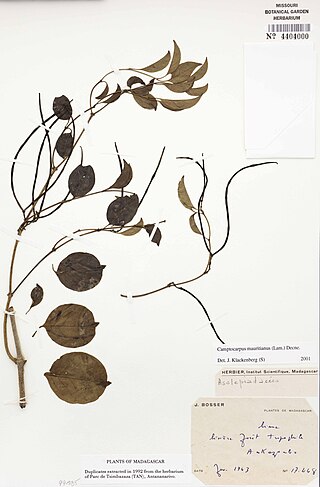
Camptocarpus mauritianus is a species of plant in the Apocynaceae family. It is native to Comoros, Madagascar and Réunion. Jean-Baptiste Lamarck, the naturalist who first formally described the species named it, using the synonym Cynanchum mauritianum, after the region of the Indian Ocean that includes the island of Mauritius, although the type specimen he examined did not list a specific location.
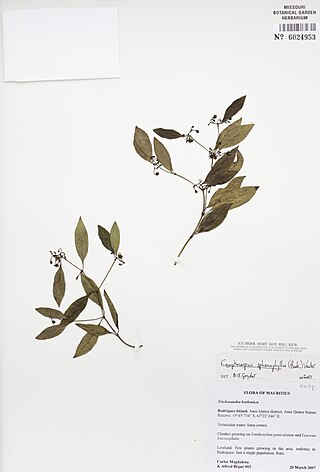
Camptocarpus sphenophyllus is a species of plant in the Apocynaceae family. It is endemic to the island of Rodrigues. Isaac Bayley Balfour, the naturalist who first formally described the species named it, using the synonym Tanulepis sphenophylla, after its wedge-shaped leaves.

Camptocarpus semihastatus is a species of plant in the Apocynaceae family. It is native to Madagascar. Jens Klackenberg, the botanist who formally described the species named it after the distinct coronal lobes of its flowers that resemble half the head of a spear.

Condylocarpon guyanense is a species of plant in the Apocynaceae family. It is native to Brazil, French Guiana, and Guyana. René Louiche Desfontaines, the botanist who first formally described the species, named it after Guyana where Joseph Martin collected the specimen he examined.

Condylocarpon isthmicum is a species of plant in the Apocynaceae family. It is native to Argentina, Brazil, Paraguay and Uruguay. José Mariano de Conceição Vellozo, the botanist who first formally described the species, named it after the narrow neck connecting the two sections of its fruit.
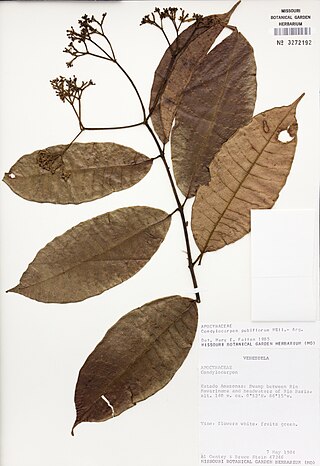
Condylocarpon pubiflorum is a species of plant in the Apocynaceae family. It is native to Bolivia, Brazil, Colombia, Peru and Venezuela. Johannes Müller Argoviensis, the botanist who first formally described the species, named it after an invalid nomen nudum, Hortsmania pubiflora, previously offered by George Bentham.
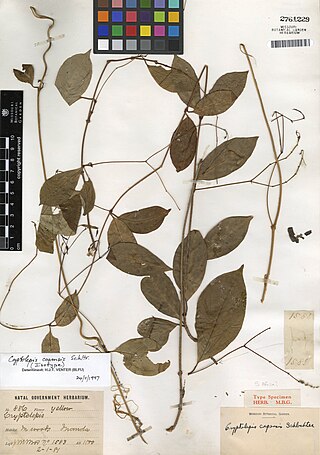
Cryptolepis capensis is a species of plant in the Apocynaceae family. It is native to South Africa and Eswatini. Rudolf Schlechter, the botanist who first formally described the species, named it after the region where the sample he examined was collected in South Africa.














